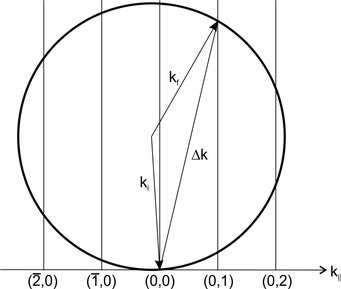LEED (Low-Energy Electron Diffraction)
In LEED a sample is illuminated with highly collimated monochromatic electrons with an energy in the regime between 20 and 500 eV. Since the de Broglie wavelength of low kinetic energy electrons is in the range of typical lattice constants large angle diffraction of the electrons by the crystalline surface takes place. In contrast to x-ray diffraction, the inelastic mean free path for low energy electrons is very small which makes this technique highly surface sensitive. However, due to the much stronger interaction of electrons with solids refraction of the electron wave at the crystal-vacuum interface and multiple scattering occurs which makes the interpretation of LEED data sometimes difficult.

Due to its high surface sensitivity the LEED pattern can be considered as a diffraction pattern from a 2-dimensional lattice. This means that in reciprocal space the z-component consists of lattice rods. Therefore, the Ewald sphere, which is used to find the Laue conditions for constructive interference, is crossing those lattice rods, which makes constructive interference much more likely as long as the wavelength of the incident beam (2π/λ) is larger than the reciprocal lattice constant.
LEED can be used in two different ways. For qualitative analysis, the observed diffraction pattern gives immediate information about the surface order and quality. Surface reconstructions or the ordering of adsorbates can be accessed since LEED gives some information about the surface symmetry and periodicities. For quantitative LEED the variation of intensity of the diffraction spots dependent on the energy is analyzed. This variation of intensity depending on the kinetic energy of the electrons is due to the third dimension of the sample, which cannot be neglected, and multiple scattering events. The spot intensity vs. kinetic energy profile has to be compared to sophisticate multiple-scattering calculations for a model system. The model system has to be adjusted until best match between calculated and measured intensities is reached.
